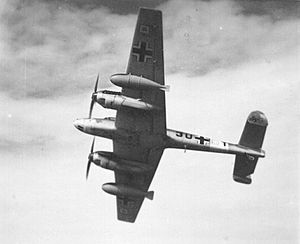Strategic fighter facts for kids

A strategic fighter is a special type of fighter aircraft. It's designed to fly fast, carry strong weapons, and travel very long distances. These planes can do many important jobs, like protecting bombers on long missions, flying deep into enemy territory for attacks, or staying on patrol far from their home base.
Long ago, these planes were called "heavy fighters" because they were big. But as technology got better, smaller, faster planes could also fly long distances. So, the idea of a strategic fighter grew to include these more agile aircraft too.
Contents
What Do Strategic Fighters Do?
Strategic fighters are a class of aircraft that can do many different jobs. They are known for being fast, well-armed, and able to fly for a long time.
Protecting Bombers
Bombers are aircraft that drop bombs. They fly slower and are not very good at turning quickly, which makes them easy targets for enemy planes. An escort fighter flies alongside the bombers, acting like a shield to protect them from attackers. In World War II, some large "heavy fighters" were built for this job. However, they were often too big and slow themselves. Later, engineers invented drop tanks. These are extra fuel tanks that can be dropped when empty. This allowed smaller, faster fighters to fly long distances and protect the bombers better.
Attacking Enemy Areas
A penetration fighter is a strategic fighter that can fly deep into enemy land. These planes are often set up for ground-attack missions, meaning they can attack targets on the ground. They can also defend themselves while doing these attacks.
Standing Patrols
Strategic fighters also fly what are called "standing patrols." This means they stay in the air for a long time, watching for any enemy aircraft. They can intercept, or stop, any planes that might be a threat. In the United States, this type of defensive patrol is called a combat air patrol (CAP).
History of Strategic Fighters
Early Ideas: 1914–1933
The idea of a strategic fighter began during World War I in Germany. They called their early battle planes Kampfflugzeug (battle aircraft) or Zerstörer (destroyer). The Dutch called them Jachtkruiser (hunter cruiser). However, none of these early designs were very successful. Even so, in 1918, British fighters flying from one of the first aircraft carriers attacked German airship bases. This showed how planes could be used for long-range attacks, like a strategic fighter.
Learning from War: 1934–1945
From 1934, several countries started building similar planes. These were sleek, twin-engined aircraft made of metal. Examples include the French Potez 63, the Polish PZL.38 Wilk, and the German Messerschmitt Bf 110. The French and German planes were the first strategic fighters made in large numbers.
The Bf 110 first flew in 1936 and was impressive then. But by the time of the Battle of Britain in 1940, it was not as good as newer, faster planes like the British Hawker Hurricane and Supermarine Spitfire. It wasn't very good at protecting bombers. American attempts with long-range escort fighters like the Lockheed P-38 Lightning also had some problems. These large planes were not as easy to maneuver as smaller, single-engined fighters like the Focke-Wulf Fw 190 or the Japanese Mitsubishi A6M Zero.
Things changed with the invention of drop tanks. These extra fuel tanks allowed smaller, lighter planes like the North American Aviation P-51 Mustang to fly much farther. Many experts say the P-51 was America's first truly successful strategic fighter.
During the later part of World War II, the USA used three types of fighters for long-range missions over Germany:
- The Lockheed P-38 Lightning had engine problems and was easy for German fighters to spot.
- The Republic P-47 Thunderbolt had to drop its extra fuel tanks before fighting, which limited its long-range use in combat.
- The North American Aviation P-51 Mustang became the most important plane for these missions and was very successful.
All three planes helped a lot. One general even said that the P-38 hurt the German air force, the P-51 finished it off, but the P-47 was the one that broke its back.
The Jet Age: 1946–Present
After World War II, during the Cold War, the US Strategic Air Command (SAC) formed special strategic fighter groups. Their main jobs were to escort bombers and fly reconnaissance (scouting) missions. They first used planes like the Republic F-84F Thunderstreak. However, it became clear that any fighter big enough to fly with the huge Boeing B-47 Stratojet bombers would be almost as big as the bomber itself!
When the even larger Boeing B-52 Stratofortress bombers arrived in 1957, the strategic fighter groups were either shut down or moved to the Tactical Air Command (TAC), which focuses on shorter-range missions.
Around this time, the McDonnell F-101 Voodoo was being developed as a deep-penetration escort fighter. It was one of the first fighters designed to fly faster than the speed of sound. Although it didn't serve with SAC, it was modified into a long-range interceptor for TAC and was used for many years in different roles.
Images for kids


